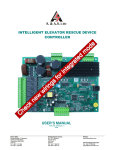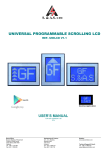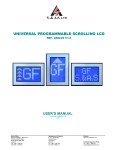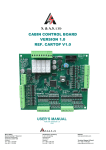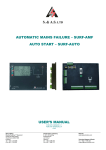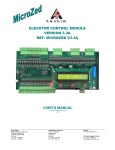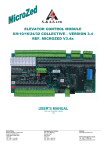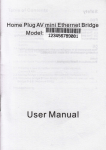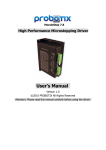Download USER`S MANUAL S. & A.S.
Transcript
S. & A.S. LTD INTELLIGENT ELEVATOR RESCUE DEVICE CONTROLLER HP – 25KW USER’S MANUAL FOR S/W VERSION 1.0 0940 Beirut Office: Boutros Building 1st Basement Cheikh-el-Ghabi Street Ghabi Beirut 2068 7808 Lebanon Tel: +961 1 216 994 Fax:+961 1 339 600 Headquarters & Factory: S. & A. S. Building Seaside Road Jieh Chouf Lebanon Tel: +961 7 996 333 Fax:+961 7 996 116 Website: www.sascontrollers.com Technical Support & Email: Tel: +961 71 996 333 [email protected] -21 OVERVIEW ........................................................................................................................................................................... 3 MAIN FEATURES ................................................................................................................................................. 3 1.2 TECHNICAL DATA ............................................................................................................................................... 3 2 GENERAL DESCRIPTION .................................................................................................................................................... 3 2.1 OPERATION ......................................................................................................................................................... 3 2.2 INSTALLATION..................................................................................................................................................... 4 2.3 EVACUATION MODES ......................................................................................................................................... 4 2.3.1 STANDALONE ............................................................................................................................................... 4 2.3.2 INTEGRATED AC2 SPD................................................................................................................................ 4 2.3.3 INTEGRATED VX2 ........................................................................................................................................ 4 3 4 CONTENTS OF PAGES DISPLAYED ON DIAGNOSTIC TOOL .......................................................................................... 4 VIEWING FAULTS AND FAULTS DESCRIPTION ................................................................................................................ 4 4.1 HOW TO VIEW THE FAULTS .............................................................................................................................. 4 4.2 HOW TO ERASE THE FAULTS ........................................................................................................................... 5 4.3 FAULT CODE DESCRIPTION .............................................................................................................................. 6 5 MENU .................................................................................................................................................................................... 6 5.1 ACCESSING THE MENU ..................................................................................................................................... 6 5.1.1 MAIN MENU DESCRIPTION ......................................................................................................................... 6 5.1.2 BOOST TIME AND BOOST TORQUE .......................................................................................................... 6 -31 OVERVIEW The Rescue device is a versatile and simple yet very effective elevator evacuation system controller. It comprises a single-phase sine wave inverter, a three-phase space vector modulated inverter and a state of the art battery charger that automatically switches between four operating modes depending of the battery charge level. The switching frequency of the inverters is 10KHz. The switching frequency of the charger is 20KHz. The four operating modes of the charger are: trickle (for depleted batteries), bulk (for discharged batteries), float (overcharging) and full (for maintaining battery charge). Ease of installation, adjustment and operation in addition to excellent performance and reliability are the strong points of this controller. To maintain battery charge, the Rescue will switch to a zero power consumption mode following a rescue operation or if it is in standby mode and the utility is absent. 1.1 MAIN FEATURES Platform Type Charger Modes Self diagnostic Measured values User interface 1.2 TECHNICAL DATA Supply voltages Line frequency Single Phase Current Rating Three Phase Current rating Switching freq. Of inverters Modulation Output freq. of 3-phase inverter Control inputs Periphery Supply Control outputs Connection 2 2.1 Digital Signal Processor Space Vector Modulation on 10KHz frequency Trickle, bulk, float or full Fault messages describing common faults Battery voltage Battery charge current Single phase inverter current Three phase inverter current Separate diagnostic tool with a 24 character, 2 lines liquid crystal display 50 to 94Vdc 45Hz to 65Hz 10Arms on 50Vrms 10Arms for Rescue, 25Arms for RescueHP 10KHz Space vector 0 to 9.9Hz Each input has a led to indicate its status – all inputs are optically isolated Active high 22Vdc – 100mA Relay outputs: 10A 250vac Optocoupler outputs: 50mA 50vdc Screw type, plug-in connectors GENERAL DESCRIPTION OPERATION The Rescue device has two operating modes: standby and ready selected by a switch on IN4, terminal P1.6: Standby: the controller will not intervene in case of a power failure. Switching to Standby mode will abort any rescue operation in progress. It also resets any error that occurred during a rescue operation. Of course, the battery charging remains operational at all times as long as there is power available. The controller switches to zero power consumption mode when the utility fails. It will automatically resume charging of batteries when the utility is restored. Ready: the battery charger is enabled as long as there is power available. Upon a power failure and if the DZ input is active, the controller will not intervene for a swinging door. On the other hand, for automatic doors, the controller will intervene after the elapse of the time set by Response to open it if the “limit switch end of opening” is not open. If LS override delay is set different than zero, the controller will intervene in all cases and will activate the door open for the time set. If DZ (IN2 on terminal P1.4) is not active, the controller will behave as follows and depending of the Evacuation Mode chosen: 1. Standalone or Integrated AC2 spd: the motor contactor is energized. If the safety circuit is closed, the contactor engages. This is detected by input IN1 on terminal P1.3. DC injection is initiated and the mechanical brake is released (contact on terminals p2.5 and p2.6). The controller will attempt to move the elevator in both directions and chooses the direction that draws the least amount of current to continue its travel until a floor level is reached. The floor level is signaled by input DZ. DC injection and mechanical brake are engaged simultaneously and after the elapse of the DZ override delay timer. -42. Integrated VX2: this evacuation mode relies on the VX2 VVVF drive to control the elevator motor. When the DZ becomes active, the rescue controller will take over and opens the door in case it is an automatic door. In all cases and after completion of the evacuation cycle, the controller will switch to zero power consumption mode. It will automatically resume normal operation and charging of batteries when the utility is restored. Please note that it is not possible to use the diagnostic tool when the controller is in zero power consumption mode. To enable the use of the diagnostic tool in this mode, place a jumper on JP5. To preserve the batteries, please remember to remove this jumper when the diagnostic tool is no longer needed. If the utility is available, the diagnostic tool will work regardless of JP5. 2.2 INSTALLATION Wiring diagrams for the three evacuation modes with different door types are attached to this document. Implement the proper wiring diagram depending on the evacuation mode selected and door type. Following is a hint on how to set a few key parameters: 1. Motor Torque: starting at 60%, increase this parameter until the elevator is able to start with no load at the highest floor, with half load at the middle floor and with full load at the lowest floor. It is advisable to use the minimum value for this parameter that ensures on one end the starting of the elevator and on another end holds the elevator preventing it from accelerating. A Motor Torque value larger than needed could result in permanent damage to the Rescue controller. 2. LS override delay: should be set to zero if the IN3 (terminal P1.5) is connected to the LS_EO (limit switch end of opening of the door). Otherwise, it should be set to a value large enough that ensures full opening of the door. 3. DZ override delay: adjust the value of this parameter to ensure an accurate stop on the floor level. Make sure that the door zone switches on for no less than 10cm on the floor. 2.3 EVACUATION MODES 2.3.1 STANDALONE In this mode, the controller will operate autonomously and will perform the task of evacuation and door opening. No connections with the elevator controller are required except for the safety circuit. No coordination with the main elevator controller is done. 2.3.2 INTEGRATED AC2 SPD In this mode, the evacuation is coordinated very closely with the ECBAB v3.3 elevator controller. The advantage of such coordination is that the elevator controller keeps track of the floor information. This evacuation mode requires that the elevator controller be powered and operational. Furthermore, it requires the connection of one control signal from the Rescue controller (OUT1 Terminal P1.7) to the SPARE IN2 of the ECBAB v3.3 controller. 2.3.3 INTEGRATED VX2 This evacuation mode requires that a VX2 VVVF drive be installed with the ECBAB v3.3 controller. The operation of this mode is similar to the Integrated ac2 spd mode with one exception: the VX2 powers the elevator motor and not the Rescue controller. 3 CONTENTS OF PAGES DISPLAYED ON DIAGNOSTIC TOOL Page 1 Page 2 4 4.1 Company name, Software version - If not in evacuation mode: 1st line: Battery Voltage (Vdc), Charger current (Idc), Mode of charger (trickle, bulk, float or full) nd 2 line: Status of the controller (Standby, Ready) - In evacuation mode: st 1 line: Single phase inverter current (Irms), Three phase inverter current (Irms) 2nd line: Status of evacuation VIEWING FAULTS AND FAULTS DESCRIPTION HOW TO VIEW THE FAULTS Pressing the middle push button will prompt the board to start displaying the last 10 faults saved in memory. The board begins by displaying the last fault. Press Previous push buttons to display the previous fault. -54.2 HOW TO ERASE THE FAULTS To erase the faults, press on the Erase push button while viewing the faults. You will be prompted to confirm your request. If Yes is pressed all faults are erased, if No is pressed, faults are not affected. -64.3 FAULT CODE DESCRIPTION Fault Message 3Ph Power Drive Error 2Ph Power Drive Error 3Ph Over Current Error 2Ph Over Current Error Safety Open in Travel Fail Close Motor C. Fail Close Door Cont. Max travel time exp. Memory Corrupted 5 Fault Description Possible short circuit Possible short circuit Internal transistors over current protection tripped Internal transistors over current protection tripped Safety circuit opened during travel Motor contactor failed to close because the safety circuit is open Door contactor failed to close The Max travel time set in the menu was exceeded before reaching a floor level The internal memory is corrupted Action taken Reset by switching to Standby mode Reset by switching to Standby mode Reset by switching to Standby mode Reset by switching to Standby mode Reset by switching to Standby mode Reset by switching to Standby mode Reset by switching to Standby mode Reset by switching to Standby mode Reset by switching to Standby mode MENU 5.1 ACCESSING THE MENU To access the menu, press the right most push button on the diagnostic tool. You will be prompted to enter a password (2802). The first digit on the left starts blinking. Use the left most push button to decrement the digit and the middle push button to increment the digit. When the desired digit is reached, push the right most push button. The digit is accepted and replaced by “*”. The next digit starts blinking. Repeat the above procedure for all remaining three digits. If you have entered the right password, access to the menu will be granted, otherwise access will be denied. Note that the push buttons have dynamic functions and their functions are at all times shown on the lower line of the display. For convenience, entry to the menu does not require the password if it is being accessed within 15 minutes after the last access. 5.1.1 MAIN MENU DESCRIPTION What you see on the display Nbre of 12V bat. Battery Capacity Response Time (sec) Door Type Description and Comments Sets the number of batteries connected Sets the capacity of the battery used in AH Sets the time for the Rescue device to intervene upon a power failure Sets the door type Factory settings Range 6 7 1 to 9 1 to 99 5 0 to 99.9 sec 380 15 25 0.5 0.5 Swinging Auto (3Ph) Auto (DC or VVVF) 190 to 999V 3.1 to 17.0A 0 to 999 0 to 99.9 sec 0 to 99.9 sec 0 0 to 99.9 sec 0.5 0 to 9.99 sec 0 0 to 255 sec 60% 60 to 150% 5 2’ 1 to 9.9Hz 5” to 9’59” Standalone Integrated ac2spd Integrated VX2 60 to 150% N/A N/A Swinging Nom. Motor Voltage Nom. Motor Current DC Brake Current (%) DC brake time start DC brake time stop LS override delay DZ override delay Nom. Door Voltage (Boost time) 2Phase Inverter Vrms (Boost torque) Evacuation Freq.(Hz) Max travel time Evac. Mode Sets the nominal voltage of the lift motor Sets the rated current of the lift motor Sets the DC brake current as a % of the rated current Sets the DC braking time during start Sets the DC braking time during stop Sets the override delay when the end of opening limit switch is reached Sets the override delay when the DZ magnet is reached Sets the nominal voltage of the automatic door motor Sets the output voltage of the single phase inverter Sets the frequency of the lift motor during evacuation Sets the maximum travel time in minutes during evacuation Sets the operating mode Standalone Motor torque (%) Load Factory Settings Exit Menu 5.1.2 Sets the torque of the lift motor Load the values shown under Default Set. Select to exit the menu 60% - BOOST TIME AND BOOST TORQUE 1. If “Boost time” is set to zero, the operation of the Rescue remains normal and the “Boost torque” is not applied at all. 2. If “Boost time” is set to 255, the “Boost torque” is applied permanently (please avoid using this case unless it is really necessary). 3. If “Boost time” is set between 1 and 254, the count of “Boost time” is started only after the Rescue has finished the load test and decided on a final direction. “Boost torque” is applied from the start of the evacuation sequence until the elapse of “Boost time”.






